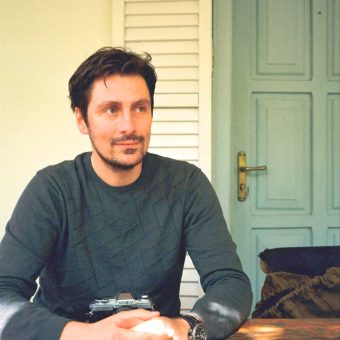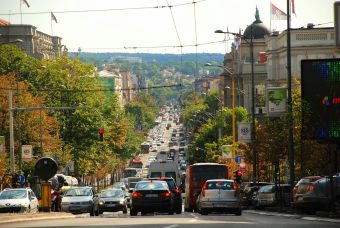
Climate change is a challenge that needs to be approached comprehensively, which also implies solving the problem of urban living as an important link. Although based on a not-so-recent idea, the so-called 15-minute-city concept has gained importance only in recent years. Namely, the concept was devised in 2016 by Professor Carlos Moreno from the Sorbonne in Paris, and it gained wide publicity in 2021 at the height of the Covid-19 pandemic. Then Anne Hidalgo, the mayor of Paris, promoted it as a strategic planning policy and a kind of urban response to the socio-economic crisis caused by the pandemic. However, as mentioned, the concept is not new but originates from urban planning and design theory. According to Professor Moreno, the idea was inspired by Jane Jacobs’ 1961 book The Death and Life of Great American Cities, considered the first comprehensive critique of 20th-century cities subordinated to the automobile and road infrastructure.
Ivan Simić, assistant professor at the Faculty of Architecture in Belgrade, with whom we talked about the problems related to urban living and the possibility of applying the 15-minute-city concept in Serbia, offered a simplified explanation. According to him, the 15-minute city is one of several related models based on the principles of chrono-urbanism. The concept rests on short intervals of 5, 10 or 15 minutes, a norm for creating autonomous city entities in neighborhoods or pedestrian and cyclist-friendly districts. The proximity and diversity of the city’s facilities within the time limit of 15 minutes shorten the commuting distances to a maximum of 1,500 meters. The concept contributes to greater mobility and facilitates energy efficiency and overall autonomy of an urban neighborhood.
Q. Are there any good examples of this concept in the world? How did they perform in practice?

A. First, we should underline historical examples of European cities that are a model for various modern urban concepts of sustainable cities, such as compact cities, pedestrian cities, or 15-minute cities. When it comes to major European cities that have kept their historical patterns, we can single out Amsterdam, Copenhagen, Prague, Florence, Edinburgh and Zurich, as well as many others. However, the authentic value of European urban heritage is the medium and small-sized cities that developed from their medieval urban nucleus. Therefore, a pedestrian-friendly city is their inherent property preserved and later served as a model for further urban development and growth.
The paradigm shift in the 1960s towards car-free neighborhoods and city centers led to a wave of urban renewal in the US, so many cities successfully transformed into urban environments ideal for pedestrians and cyclists, such as Boston, San Francisco, Philadelphia, and Washington D.C.
Many modern examples rest on these principles. It takes time to determine whether they have been successfully implemented. Evolutionarily designed city units, which have been developed by many participants over a long period, have proven to be a more successful model of development than those that were designed and implemented in one breath.
IN FOCUS:
- SOCIAL NETWORKS FROM A DIFFERENT ECO-ANGLE
- SOLVING PROBLEMS WITH HIGHER HARMONICS
- ECOLOGY EMBASSY IN THE CULTURE STREET
Q. Could any parts of larger cities in Serbia, especially Belgrade, fit into this concept?
A. From the 1950s to 1980s, Belgrade had a very modern planning practice, the most prominent representative of which is the General Urban Plan (GUP) from 1972, which was publicly presented under an impressive slogan “Archipelago of Neighborhoods in the Sea of Greenery“. This was the vision of Belgrade until the year 2000: to have polycentric development with new satellite neighborhoods surrounded by green areas and with all the necessary central functions. This made them autonomous urban areas, which coincided with the principles of the 15-minute city. Banovo Brdo is an example of a Belgrade neighborhood that sprung up spontaneously but was built according to Pešić’s plan and fitted into the mould of a 15-minute city. Although Banovo Brdo is not ideal because of the many challenges it has faced in the last two decades, such as e.g. excessive construction and lack of parking space, it is a good example of a neighborhood where you can find almost everything you want, in a space-time dimension of 15 minutes or about 1,500 meters.

This is not the only example of a city within a city in Belgrade. Vidikovac, Sava blocks, Senjak, Dorćol and many other Belgrade neighborhoods complement the 15-minute city concept. Unfortunately, unplanned urban development and construction threaten to disturb the balance of these neighborhoods. Excessive construction, overpopulation, car traffic and scarce green areas act as dystopian processes, especially against the vision of an archipelago of neighborhoods in the sea of greenery of the 1972 General Urban Plan, which is a precious heritage because it offered visionary solutions to issues that are very topical today.
Q. How can we increase the number of such neighborhoods in Serbian citizens, and what are the biggest challenges and obstacles related to their implementation?
A. To implement this or similar concepts, we should have a strategic approach to planning our cities and a good alignment between the strategic level and the existing system of urban plans of general and detailed regulation. That should be guided and harmonized by good strategic documents that must be consistently implemented to get the expected results. The Strategy of Sustainable Urban Development of Serbia, which covers the period until 2030, is an example of such a document adopted. It was passed in 2019.
As in the case of European cities, we can also look up to good historical examples from very different eras of urban development. A bazaar is a linear urban pattern from the Turkish period based on the idea of a central pedestrian street containing everything required for a person to meet their daily needs. The legacy of Central European urbanism in Vojvodina is an orthogonal network of streets and public spaces planned for cyclists and pedestrians.
Interviewed by: Katarina Vuinac
Read the story in the new issue of the Energy portal Magazine SUSTAINABLE ARCHITECTURE AND FINANCING OF GREEN CONSTRUCTION



